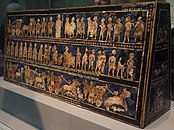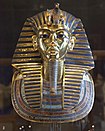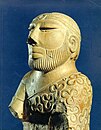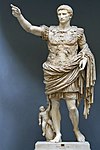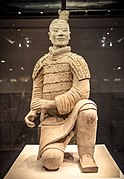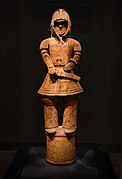Ancient history
| Ancient history |
|---|
| Preceded byprehistory |
|
| Part ofa serieson |
| Human history |
|---|
| ↑Prehistory(Stone Age)(Pleistocene epoch) |
| ↓Future |
Ancient historyis atime periodfrom thebeginning of writingand recordedhuman historythroughlate antiquity.The span ofrecorded historyis roughly 5,000 years, beginning with the development ofSumeriancuneiformscript and continuing until theexpansion ofIslaminlate antiquity.Ancient history covers all continents inhabited by humans in the period 3000 BC – AD 500.[1]Thethree-age systemperiodizes ancient history into theStone Age,theBronze Age,and theIron Age,with recorded history generally considered to begin with the Bronze Age. The start and end of the three ages vary between world regions. In many regions the Bronze Age is generally considered to begin a few centuries prior to 3000 BC, while the end of the Iron Age varies from the early first millennium BC in some regions to the late first millennium AD in others.
During the time period of ancient history, theworld populationwas alreadyexponentially increasingdue to theNeolithic Revolution,which was in full progress. While in 10,000 BC, the world population stood at 2 million, it rose to 45 million by 3000 BC. By the Iron Age in 1000 BC, the population had risen to 72 million. By the end of the ancient period in AD 500, the world population is thought to have stood at 209 million. In 10,500 years, the world population increased by 100 times.[2]
Prehistory
[edit]Prehistoryis the period before written history. Most of our knowledge of that period comes from the work of archaeologists.[3]Prehistory is often known as theStone Age,and is divided into thePaleolithic(earliest),Mesolithic,andNeolithic.[4]
Theearly human migrationsin theLower PaleolithicsawHomo erectusspread acrossEurasia1.8 million years ago.[5]Evidence for the use of fire has been dated as early as 1.8 million years ago, a date which is contested,[6]with generally accepted evidence for the controlled use of fire dating to 780,000 years ago. Actual use of hearths first appears 400,000 years ago.[7]Dates for the emergence ofHomo sapiens(modern humans) range from 250,000[8]to 160,000 years ago,[9]with the varying dates being based onDNA studies[8]andfossilsrespectively.[9]Some 50,000 years ago,Homo sapiensmigrated out ofAfrica.They reachedAustraliaabout 45,000 years ago, southwesternEuropeabout the same time, southeastern Europe andSiberiaaround 40,000 years ago, andJapanabout 30,000 years ago. Humansmigrated to the Americasabout 15,000 years ago.[10]
Evidence foragricultureemerges in about 9000 BC in what is now easternTurkeyand spread through theFertile Crescent.[11]Settlement atGöbekli Tepebegan around 9500 BC and may have the world's oldest temple.[12]TheNile River Valleyhas evidence ofsorghumandmilletcultivation starting around 8000 BC and agricultural use ofyamsin Western Africa perhaps dates to the same time period. Cultivation of millet,rice,andlegumesbegan around 7000 BC inChina.Tarocultivation inNew Guineadates to about 7000 BC also withsquashcultivation inMesoamericaperhaps sharing that date.[11]Animal domesticationbegan with thedomestication of dogs,which dates to at least 15,000 years ago, and perhaps even earlier.Sheepandgoatswere domesticated around 9000 BC in the Fertile Crescent, alongside the first evidence for agriculture. Other animals, such aspigsandpoultry,were later domesticated and used as food sources.[13]Cattleandwater buffalowere domesticated around 7000 BC andhorses,donkeys,andcamelswere domesticated by about 4000 BC. All of these animals were used not only for food, but to carry and pull people and loads, greatly increasing human ability to do work. The invention of the simpleploughby 6000 BC further increased agricultural efficiency.[14]
Metal use in the form of hammeredcopperitems predates the discovery ofsmeltingofcopper ores,which happened around 6000 BC in western Asia and independently in eastern Asia before 2000 BC.Goldandsilveruse dates to between 6000 and 5000 BC.Alloymetallurgy began withbronzein about 3500 BC inMesopotamiaand was developed independently in China by 2000 BC.[15]Potterydeveloped independently throughout the world,[16]with fired pots appearing first among theJomonof Japan and in West Africa atMali.[17]Sometime between 5000 and 4000 BC thepotter's wheelwas invented.[16]By 3000 BC,[18]the pottery wheel was adapted intowheeled vehicleswhich could be used to carry loads further and easier than with human or animal power alone.[16]
Writingdeveloped separately in five different locations in human history: Mesopotamia, Egypt, India, China, and Mesoamerica.[19]By 3400 BC, "proto-literate"cuneiformspread in the Middle East.[20]Egypt developed its own system ofhieroglyphsby about 3200 BC.[19]By 2800 BC theIndus Valley civilizationhad developed itsIndus script,which remains undeciphered.[21]Chinese Characterswere independently developed in China during theShang dynastyin the form of theOracle Bone Scriptdating to the period 1600 to 1100 BC.[22]Writing in Mesoamerica dates to 600 BC with theZapotec civilization.[23]
History by region
[edit]West Asia
[edit]The ancient Near East is considered thecradle of civilization.[24]It was the first to practice intensive year-round agriculture;[citation needed]created one of the firstcoherent writing systems,[19]invented thepotter's wheeland then the vehicularwheel,[16]created the firstcentralized governments,[25]law codes[26]and empires,[27]as well as displayingsocial stratification,[24]slavery,[26]and organized warfare.[28]It began the study of the stars and the sciences of astronomy and mathematics.[29]

Mesopotamia
[edit]Mesopotamia is the site of some of the earliest knowncivilisationsin the world.[30]Agricultural communities emerged in the area with theHalaf culturearound 8000 BC and continued to expand through theUbaid periodaround 6000 BC.[31]Cities began in theUruk period(4000–3100 BC) and expanded during theJemdet Nasr(3100–2900 BC) andEarly Dynastic(2900–2350 BC) periods.[32]The surplus of storable foodstuffs created by this economy allowed the population to settle in one place instead of migrating after crops and herds. It also allowed for a much greater population density, and in turn required an extensive labour force and division of labour.[17]This organization led to the necessity of record keeping and the development of writing.[33]
Babyloniawas anAmoritestate in lower Mesopotamia (modern southernIraq),[34]with Babylon as its capital. Babylonia emerged whenHammurabicreated an empire out of the territories of the former kingdoms ofSumerandAkkad.[34]
TheNeo-Babylonian Empire,orChaldea,was Babylonia from the 7th and 6th centuries BC.[35]Under the reign ofNebuchadnezzar II,it conqueredJerusalem.This empire also created theHanging Gardens of Babylonand the still-survivingIshtar Gateas architectural embellishments of its capital at Babylon.[36]
Akkadwas a city and its surrounding region near Babylon. Akkad also became the capital of the Akkadian Empire.[37]Despite an extensive search, the precise site has never been found. Akkad reached the height of its power between about 2330 and 2150 BC, following the conquests of KingSargon of Akkad.[37]Through the spread of Sargon's empire, the language of Akkad, known asAkkadianfrom the city, spread and replaced the Sumerian language in Mesopotamia and eventually by 1450 BC was the main language of diplomacy in the Near East.[38]
Assyriawas originally a region on the UpperTigris,where a small state was created in the 19th century BC.[35]The capital was atAssur,which gave the state its name.[39]Later, as a nation and empire that came to control all of the Fertile Crescent, Egypt and much ofAnatolia,the term "Assyria proper" referred to roughly the northern half of Mesopotamia (the southern half being Babylonia), withNinevehas its capital. The Assyrian kings controlled a large kingdom at three different times in history. These are called theOld(20th to 18th centuries BC),Middle(14th to 11th centuries BC), andNeo-Assyrian(9th to 7th centuries BC) kingdoms, or periods.[40]
Mitanniwas a Hurrian empire in northern Mesopotamia founded around 1500 BC. The Mitanians conquered and controlled Assyria until the 14th century BC while contending with Egypt for control of parts of modern Syria. Its capital wasWashukanni,whose precise location has not been determined by archaeologists.[41]
Iranian peoples
[edit]TheMedesandPersianswere peoples who had appeared in the Iranian plateau around 1500 BC.[42]Both peoples spokeIndo-European languagesand were mostly pastoralists with a tradition of horse archery.[43]The Medes established their ownMedian Empireby the 6th century BC, having defeated the Neo-Assyrian Empire with theChaldeansin 614 BC.[36]
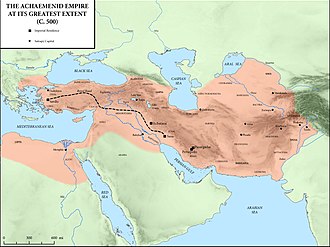
TheAchaemenid Empirewas founded byCyrus the Great,who first became king of the Persians, then conquered the Medes,Lydia,and Babylon by 539 BC. The empire built on earlier Mesopotamian systems of government to govern their large empire. By building roads, they improved both the ability to send governmental instructions throughout their lands as well as improving the ability of their military forces to be deployed rapidly. Increased trade and upgraded farming techniques increased wealth, but also exacerbated inequalities between social classes. The empire's location at the centre of trading networks spread its intellectual and philosophical ideas throughout a wide area, and its religion, while not itself spreading far, had an impact on later religions such asChristianity,Islam,andJudaism.[43]Cyrus' sonCambyses IIconquered Egypt, while a later emperor,Darius the Great,expanded the empire to theIndus River,creating the largest empire in the world to that date.[44]But Darius and his sonXerxes Ifailed to expand intoGreece,with expeditions in 490 and 480 BC eventually failing.[45]The Achaemenid dynasty and empire fell toAlexander the Greatby 330 BC, and after Alexander's death, much of the area previously ruled by the Cyrus and his successors was ruled by theSeleucid dynasty.[46]

Parthiawas an Iranian civilisation situated in the northeastern part of modern Iran. Their power was based on a combination of military power based on heavy cavalry with a decentralised governing structure based on afederated system.[47]TheParthian Empirewas led by theArsacid dynasty,[citation needed]which by around 155 BC underMithradates Ihad mostly conquered theSeleucid Empire.Parthia had many wars with the Romans, but it was rebellions within the empire that ended it in the 3rd century AD.[47]
TheSasanian Empirebegan when the Parthian Empire ended in AD 224. Their rulers claimed the Achaemenids as ancestors and set up their capital atCtesiphonin Mesopotamia. Their period of greatest military expansion occurred underShapur I,who by the time of his death in AD 272 had defeated Roman imperial armies and set up buffer states between the Sasanians and Roman Empires. After Shapur, the Sasanians were under more pressure from the Kushans to their east as well as the Roman then Byzantine Empire to its west. However, the Sasanians rebuilt and founded numerous cities and their merchants traveled widely and introduced crops such as sugar, rice, and cotton into the Iranian plateau. But in AD 651, the last Sassanid emperor was killed by the expanding Islamic Arabs.[48]
Hittites
[edit]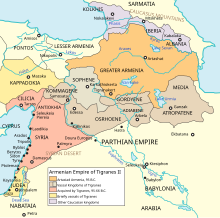
TheHittitesfirst came to Anatolia about 1900 BC and during the period 1600-1500 they expanded into Mesopotamia where they adopted the cuneiform script to their Indo-European language. By 1200 their empire stretched toPhoeniciaand easternAnatolia.They improved two earlier technologies from Mesopotamia and spread these new techniques widely – improved iron working and lightchariotswithspoked wheelsin warfare. The Hittites introduced the casting of iron with molds and then hammering it which enabled weapons and tools to be made stronger and also cheaper. Although chariots had been used previously, the use of spoked wheels allowed the chariots to be much lighter and more maneuverable.[49]In 1274 BC the Hittites clashed with the Egyptians at theBattle of Kadesh,where both sides claimed victory. In 1207 the Hittite capital ofHattusawas sacked, ending theHittite Empire.[50]
Israel
[edit]
IsraelandJudahwere related Iron Age kingdoms of the ancient Levant and had existed during the Iron Ages and the Neo-Babylonian, Persian and Hellenistic periods. The name Israel first appears in thesteleof the Egyptian pharaohMerneptaharound 1209 BC.[51]This "Israel" was a cultural and probably political entity of the central highlands, well enough established to be perceived by the Egyptians as a possible challenge to theirhegemony,but an ethnic group rather than an organised state.[52]
Israel had emerged by the middle of the 9th century BC, when the Assyrian KingShalmaneser IIInamed "Ahabthe Israelite "among his enemies at thebattle of Qarqar(853). Judah emerged somewhat later than Israel, probably during the 9th century BC, but the subject is one of considerable controversy.[53]Israel came into conflict with the Assyrians, who conquered Israel in 722 BC. TheNeo-Babylonian Empiredid the same to Judah in 586. After both conquests, the conquering forces deported many of the inhabitants to other regions of their respective empires.[54]
Following the fall of Babylon to the Persian Empire, Cyrus the Great allowed the rebuilding of the temple atJerusalem,[55]and some of the exiles from Judahreturned to Judea,[56]where they remained under Persian rule until theMaccabean revoltled to independence during Hellenistic period untilRoman conquest.[57]
Phoenicia
[edit]Phoeniciawas an ancient civilisation centered in the north of ancientCanaan,with its heartland along the coastal regions of modern-dayLebanon,Syria and Israel. Phoenician civilisation was an enterprisingmaritime trading culturethat spread across theMediterraneanbetween the period of 1550 to 300 BC.[58]One Phoenician colony,Carthage,ruled an empire in the Western Mediterranean until being defeated by Rome in thePunic Wars.[59]The Phoenicians invented thePhoenician Alpha bet,the forerunner of the modernAlpha betstill in use today.[60]
Arabia
[edit]The history of Pre-Islamic Arabia before the rise ofIslamin the AD 630s is not known in great detail.[61]Archaeological exploration in theArabian peninsulahas been sparse; indigenous written sources are limited to the many inscriptions and coins from southern Arabia. Existing material consists primarily of written sources from other traditions (such as Egyptians, Greeks, Persians, Romans, etc.) andoral traditionslater recorded by Islamic scholars.[citation needed]A number of small kingdoms existed in Arabia from around AD 100 to perhaps about AD 400.[61]
Africa
[edit]Afro-Asiatic Africa
[edit]Carthage
[edit]Carthage was founded around 814 BC byPhoeniciansettlers.[59]Ancient Carthagewas a city-state that ruled an empire through alliances and trade influence that stretched throughout North Africa and modernSpain.[62]At the height of the city's influence, its empire included most of the western Mediterranean.[59]The empire was in a constant state of struggle with theRoman Republic,which led to a series of conflicts known as thePunic Wars.After the third andfinal Punic War,Carthage was destroyed and then occupied by Roman forces. Nearly all of the territory held by Carthage fell into Roman hands.[63]
Egypt
[edit]
Ancient Egypt was a long-lived civilisation geographically located in north-eastern Africa. It was concentrated along the middle to lower reaches of the Nile River,[64]reaching its greatest extent during the 2nd millennium BC, which is referred to as the New Kingdom period.[65]It reached broadly from theNile Deltain the north, as far south asJebel Barkalat theFourth Cataractof the Nile. Extensions to the geographical range of ancient Egyptian civilisation included, at different times, areas of the southernLevant,the Eastern Desert and the Red Sea coastline, theSinai Peninsula,[66]and theWestern Desert(focused on the severaloases).
Ancient Egypt developed over at least three and a halfmillennia.[64]It began with the incipient unification of Nile Valley polities around 3100 BC, traditionally underMenes.[67]The civilisation of ancient Egypt was characterised primarily by intensive agricultural use of the fertile Nile Valley;[68]the use of the Nile itself for transportation;[69]the development of writing systems – firsthieroglyphsand then laterhieraticand other derived scripts – andliterature;[70]the organisation of collective projects such as thepyramids;[71]tradewith surrounding regions;[72]and apolytheisticreligious tradition that included elaborate funeral customs includingmummification.[73]Overseeing these activities were a socio-political and economicelite[74]under the figure of a (semi)-divine ruler from a succession of rulingdynasties.[75]
Ancient Egyptian history is divided across various periods, beginning with theOld Kingdom,which saw pyramid building on a large scale. After 2100 BC, the Old Kingdom dissolved into smaller states during theFirst Intermediate Period,which lasted about 100 years.[76]TheMiddle Kingdombegan around 2000 BC with the reunification of Egypt under pharoes ruling fromThebes.The Middle Kingdom ended with the conquest of northern Egypt by theHyksosaround 1650 BC.[77]The Hyksos were expelled from Egypt and the land was reunited in theNew Kingdomaround 1550 BC. This period lasted until about 1000 BC, and saw Egypt expand its borders into Palestine and Syria. TheThird Intermediate Periodwas marked by the rule of priests as well as the conquest of Egypt byNubiankings and then later Assyria, Persia, and Macedonians.[65]
Nubia
[edit]
The Ta-Seti kingdom inNubiato the south ofEgyptwas conquered by Egyptian rulers around 3100 BC, but by 2500 BC the Nubians had created a new kingdom further south, known as theKingdom of Kush,centred on the upper Nile with a capital atKerma.[78]In theEgyptian New Kingdomperiod, Kush once more was conquered by Egypt. However, by 1100 BC a new kingdom of Kush had formed, with a capital atNapata.Nubian rulers conquered Egypt around 760 BC and retained control for about a century.[79]
Aksum and ancient Ethiopia
[edit]
TheKingdom of Aksumwas an important trading nation in northeastern Africa centered in present-dayEritreaand northernEthiopia,it existed from approximately AD 100 to 940, growing from the Iron Age proto-Aksumite period around the 4th century BC to achieve prominence by the 1st century AD.[80]The Kingdom of Aksum at its height by the early 6th-century AD extended through much of modern Ethiopia and across theRed Seato Arabia. The capital city of the empire wasAksum,now in northern Ethiopia.[81]
Niger-Congo Africa
[edit]Nok culture
[edit]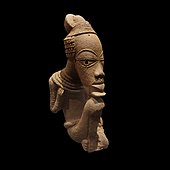
The Nok culture appeared inNigeriaaround 1000 BC and mysteriously vanished around AD 200. The civilisation'ssocial systemis thought to have been highly advanced. The Nok civilisation was considered to be the earliest sub-Saharan producer of life-sized Terracotta which have been discovered by archaeologists. The Nok also usediron smeltingthat may have been independently developed.[82]
Sahel
[edit]Djenné-Djenno
[edit]The civilisation of Djenné-Djenno was located in the Niger River Valley in the country ofMaliand is considered to be among the oldest urbanized centers and the best-known archaeology site insub-Saharan Africa.This archaeological site is located about 3 kilometers (1.9 miles) away from the modern town and is believed to have been involved inlong-distance tradeand possibly the domestication of African rice. The site is believed to exceed 33 hectares (82 acres); however, this is yet to be confirmed with extensive survey work. With the help of archaeological excavations mainly bySusan and Roderick McIntosh,the site is known to have been occupied from 250 BC to AD 900. The city is believed to have been abandoned and moved where the current city is located due to the spread of Islam and the building of theGreat Mosque of Djenné.Previously, it was assumed that advanced trade networks and complexsocietiesdid not exist in the region until the arrival of traders fromSouthwest Asia.However, sites such as Djenné-Djenno disprove this, as these traditions inWest Africaflourished long before. Towns similar to that at Djenne-Jeno also developed at the site of Dia, also in Mali along theNiger River,from around 900 BC.
Dhar Tichitt and Oualata
[edit]Dhar Tichitt and Oualata were prominent among the early urban centres, dated to 2000 BC, in present-day Mauritania. About 500 stone settlements littered the region in the former savannah of the Sahara. Its inhabitants fished and grew millet. It has been found that the Soninke of the Mandé peoples were responsible for constructing such settlements. Around 300 BC, the region became more desiccated and the settlements began to decline, most likely relocating to Koumbi Saleh. From the type of architecture and pottery, it is believed that Tichit was related to the subsequent Ghana Empire. Old Jenne (Djenne) began to be settled around 300 BC, producing iron and with sizeable population, evidenced in crowded cemeteries. The inhabitants and creators of these settlements during these periods are thought to have been ancestors of the Soninke people.
Bantu expansion
[edit]Peoples speaking precursors to the modern-dayBantu languagesbegan to spread throughout southern Africa, and by 2000 BC they were expanding past theCongo Riverand into theGreat Lakesarea. By AD 1000 these groups had spread throughout all of southern Africa south of the equator.[83]Iron metallurgy and agriculture spread along with these peoples, with the cultivation of millet, oil palms, sorghum, and yams as well as the use of domesticated cattle, pigs, and sheep. These technologies helped increase population, and settled communities became common in sub-Saharan Africa except in deserts or heavy forests.[84]
South Asia
[edit]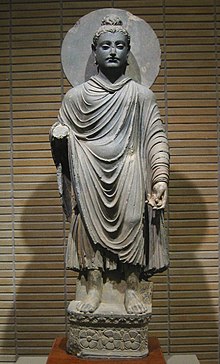
Paleolithic toolshave been discovered in India dating to 200,000 years ago, and neolithic sites are known from near theIndus Valleydating to around 8000 BC.[85]Agriculture began in the Indus Valley around 7000 BC,[85]and reached theGanges Valleyby 3000 BC.[86]Barley,cotton,and wheat were grown and the population had domesticated cattle, goats, and sheep.[85]

TheIndus Valley civilizationdeveloped around 3000 BC in theIndusandGhaggar-Hakrariver valleys of easternAfghanistan,Pakistan, and western India. Another name for this civilisation is Harappan,[21]after the first of its cities to be excavated,Harappain the Pakistani province ofPunjab.[citation needed]Harappan civilization grew out of the earlier agricultural communities as they evolved into cities. These communities created and traded jewelry, figurines, and seals that appear widely scattered throughout Mesopotamia, Afghanistan, and Iran.[87]Chickenswere domesticated in addition to the earlier crops and animals.[88]They developed their own writing system, theIndus Valley script,which is still mostly undeciphered.[21]The exact structure of society and the way the cities were governed is not known.[88]By about 1600 BC, the Indus Valley culture had abandoned many of their cities, includingMohenjo-Daro.[89]The exact reason for this decline is not known.[90]
Indo-European speaking peoples began to spread into India about 1500 BC. TheRigveda,inSanskrit,dates to this period and begins a period often known as theVedic period.[91]Between 1500 and 500 BC these peoples spread throughout most of India and had begun to found small cities.[92]Vedic society was characterized by thevarnasystem which divided society into four broad castes, which were later elaborated. By the end of the Vedic period, this way of organizing society had become central to Indian society.[93]Religion in the late Vedic period was evolving intoHinduism,which spread throughout Southeast Asia.[94]Siddhartha Gautama,born around 560 BC in northern India, went on to found a new religion based on his ascetic life –Buddhism.This faith also spread throughout Eastern and Southeastern Asia after his death.[95]This period also saw the composition of the epicsRamayanaandMahabharata.[94]
The kingdom ofMagadharose to prominence under a number of dynasties that peaked in power under the reign ofAshokaMaurya, one of India's most legendary and famous emperors. During the reign of Ashoka, the four dynasties ofChola,Chera,andPandyawere ruling in the South, whileDevanampiya Tissa(250–210 BC) controlledAnuradhapura(nowSri Lanka). These kingdoms, while not part of Ashoka's empire, were in friendly terms with theMaurya Empire.An alliance existed between Devanampiya Tissa and Ashoka of India,[96]who sent Buddhist missionaries to Sri Lanka.[97]
Most ofNorth Indiawas reunited under theGupta Empirebeginning underChandragupta Iaround AD 320. Under his successors the empire spread to include much of India except for the Deccan Plateau and the very south of the peninsula.[98]This was a period of relative peace, and the Gupta rulers generally left administration in local rulers. The Gupta Empire was weakened and ultimately ruined by the raids ofHunas(a branch of theHephthalitesemanating from Central Asia), and the empire broke up into smaller regional kingdoms by the end of the fifth century AD. India would remain fragmented into smaller states until the rise of theMughal Empirein the 1500s.[99]
Southeast Asia & Oceania
[edit]TheNeolithicperiod ofSoutheast Asiawas characterized by several migrations intoMainlandandIsland Southeast Asiafrom southernChinabyAustronesian,Austroasiatic,Kra-DaiandHmong-Mien-speakers.[100]
Territorial principalities in both Insular and Mainland Southeast Asia, characterized as "agrarian kingdoms",[101]developed an economy by around 500 BCE based on surplus crop cultivation and moderate coastal trade of domestic natural products. Several states of the Malayan-Indonesian "thalassian"zone[102]shared these characteristics with Indochinese polities like thePyu city-statesin theIrrawaddy Rivervalley, theVăn Lang kingdomin theRed River DeltaandFunanaround the lowerMekong.[103]Văn Lang, founded in the 7th century BCE, endured until 258 BCE under theHồng Bàng dynasty,as part of theĐông Sơn culturethat sustained a dense and organised population that produced an elaborateBronze Ageindustry.[104][105]
Intensive wet-rice cultivationin an ideal climate enabled the farming communities to produce a regular crop surplus that was used by the ruling elite to raise, command and pay work forces for public construction and maintenance projects such as canals and fortifications.[104][102]
Mainland Southeast Asia
[edit]
The earliest known evidence of copper and bronze production in Southeast Asia was found atBan Chiangin north-east Thailand and among thePhùng Nguyên cultureof northern Vietnam around 2000 BCE.[106]
TheĐông Sơnculture established a tradition of bronze production and the manufacture of evermore refined bronze and iron objects, such as plows, axes and sickles with shaft holes, socketed arrows and spearheads and small ornamented items.[107]By about 500 BCE, large and delicately decorated bronze drums of remarkable quality, weighing more than 70 kg (150 lb), were produced in the laboriouslost-wax castingprocess. This industry of highly sophisticated metal processing was developed independent of Chinese or Indian influence. Historians relate these achievements to the presence of organized, centralized and hierarchical communities and a large population.[108]
Between 1000 BCE and 100 CE, theSa Huỳnh cultureflourished along the south-central coast ofVietnam.[109]Ceramic jar burial sites that included grave goods have been discovered at various sites along the entire territory. Among large, thin-walled terracotta jars, ornamented and colorized cooking pots, glass items,jadeearrings and metal objects were deposited near the rivers and along the coast.[110]
Austronesia
[edit]
Around 3000 to 1500 BCE, a large-scale migration ofAustronesians,known as theAustronesian expansionbegan fromTaiwan.Population growthprimarily fueled this migration. These first settlers settled in northernLuzon,in the archipelago of thePhilippines,intermingling with the earlierAustralo-Melanesianpopulation who had inhabited the islands since about 23,000 years earlier. Over the next thousand years, Austronesian peoples migrated southeast to the rest of the Philippines, and into the islands of theCelebes Seaand Borneo.[111][112]From southwestern Borneo, Austronesians spread further west in a single migration event to bothSumatraand the coastal regions of southern Vietnam, becoming the ancestors of the speakers of theMalayicandChamicbranches of the Austronesian language family.[113]
Soon after reaching the Philippines, Austronesians colonized theNorthern Mariana Islandsby 1500 BCE or even earlier, becoming the first humans to reachRemote Oceania.TheChamorromigration was also unique in that it was the only Austronesian migration to the Pacific Islands to successfully retain rice cultivation.PalauandYapwere settled by separate voyages by 1000 BCE.[113][111][112]
Another important migration branch was by theLapita culture,which rapidly spread into the islands off the coast of northernNew Guineaand into theSolomon Islandsand other parts of coastal New Guinea andIsland Melanesiaby 1200 BCE. They reached the islands ofFiji,Samoa,andTongaby around 900 to 800 BCE. This remained the furthest extent of the Austronesian expansion into Polynesia until around 700 CE, when there was another surge of island colonization. It reached theCook Islands,Tahiti,and theMarquesasby 700 CE;Hawaiiby 900 CE;Rapa Nuiby 1000 CE; and New Zealand by 1200 CE.[114][115][116]For a few centuries, the Polynesian islands were connected by bidirectional long-distance sailing, with the exception of Rapa Nui, which had limited further contact due to its isolated geographical location.[113]Island groups like thePitcairns,theKermadec Islands,and theNorfolk Islandswere also formerly settled by Austronesians but later abandoned.[116]There is also putative evidence, based in the spread of thesweet potato,that Austronesians may have reached South America from Polynesia, where they might have traded with theIndigenous peoples of the Americas.[117][118]
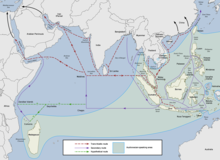
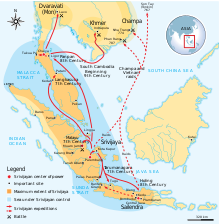
Austronesians established prehistoricmaritime trade networksin Island Southeast Asia, including theMaritime Jade Road,a jade trade network, in Southeast Asia which existed inTaiwanand thePhilippinesfor 3,000 years from 2000 BCE to 1000 CE. The trade was established by links between the indigenous peoples of Taiwan and the Philippines, and later included parts of Vietnam, Malaysia, Indonesia, Thailand, and other areas in Southeast Asia (known as theSa Huynh-KalanayInteraction Sphere).Lingling-oartifacts are one of the notable archeological finds originating from the Maritime Jade Road.[120][121][122][123]During the operation of the Maritime Jade Road, the Austronesianspice tradenetworks were also established byIslander Southeast AsianswithSri LankaandSouthern Indiaby around 1000 to 600 BCE.[124][125][126]
They also established early long-distance contacts with Africa, possibly as early as before 500 BCE, based on archaeological evidence like bananaphytolithsinCameroonandUgandaand remains of Neolithic chicken bones inZanzibar.[127][128]An Austronesian group, originally from theMakassar Straitregion aroundKalimantanandSulawesi,[129][130]eventuallysettledMadagascar,either directly from Southeast Asia or from preexisting mixed Austronesian-Bantupopulations fromEast Africa.Estimates for when this occurred vary from the 1st century CE,[126]to as late as the 6th to 7th centuries CE.[127][128]It is likely that the Austronesians that settled Madagascar followed a coastal route through South Asia and East Africa, rather than directly across the Indian Ocean.[113]Genetic evidence suggests that some individuals of Austronesian descent reached Africa and theArabian Peninsula.[131]
By around the 2nd century BCE, theNeolithicAustronesian jade and spice trade networks in Southeast Asia connected with the maritime trade routes ofSouth Asia,theMiddle East,easternAfrica,and theMediterranean,becoming what is now known as theMaritime Silk Road.Prior to the 10th century, the eastern part of the route was primarily used by Southeast Asian Austronesian traders using distinctivelashed-lugships, althoughTamilandPersiantraders also sailed the western parts of the routes.[132][133]It allowed the exchange of goods fromEastand Southeast Asia on one end, all the way toEuropeand eastern Africa on the other.[133]
Srivijaya,an Austronesian polity founded atPalembangin 682 CE, rose to dominate the trade in the region around the straits ofMalaccaandSundaand the South China Seaemporiumby controlling the trade in luxury aromatics and Buddhist artifacts from West Asia to a thriving Tang market.[132]: 12 It emerged through the conquest and subjugation of neighboring thalassocracies. These includedMelayu,Kedah,Tarumanagara,andMataram,among others. These polities controlled the sea lanes in Southeast Asia and exploited the spice trade of theSpice Islands,as well as maritime trade-routes betweenIndiaandChina.[134]
East Asia
[edit]China
[edit]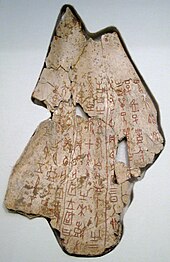
The Chinese civilisation that emerged within theYellow Rivervalley is one of earliest civilisations in the world.[135]Prior to the formation of civilisation, neolithic cultures such as theLongshanandYangshaodating to 5000 BC produced sophisticated pottery, cultivated millet, and likely produced clothes woven fromhempandsilk.[136]Rice was also farmed and pigs andwater buffalowere kept for food. Longshan potters may have used the pottery wheel to produce their wares.[137]Ancient Chinese traditions described threeancient dynastiesthat predated the unification under theQinandHandynasties. These were theXia,theShang,and theZhou.It was not until the later 20th century that many historians considered the Shang or Xia to be anything other than legendary.[138]Little is yet known about the Xia, which appears to have begun around 2200 BC, and may have controlled parts of theYangtze Rivervalley.[139]
The Shang dynasty traditionally is dated to 1766 to 1122 BC. Bronze was central to Shang culture and technology, with chariots and bronze weapons helping to expand Shang control over northern China. The cities at Ao andYinxu,nearAnyang,have been excavated and city walls, royal palaces, and archives as well as tombs and workshops were found.[140]A system of writing developed, beginning withoracle bones,of which over 100,000 are still extant.[141]
Towards the end of the 2nd millennium BC, the Shang were overrun by theZhou dynastyfrom theWei Rivervalley to the west. The Zhou rulers at this time invoked the concept of theMandate of Heavento legitimize their rule, a concept that would be influential for almost every successive dynasty. The Zhou initially established their capital in the west near modernXi'an,near the Yellow River, but they would preside over a series of expansions into the Yangtze River valley. Zhou administration was decentralised, with local elites responsible for collecting tribute and providing military support to the Zhou rulers.[142]
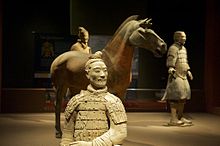
In the 8th century BC, power became decentralized during theSpring and Autumn period,[143]named after the influentialSpring and Autumn Annals.[144]In this period, local military leaders used by the Zhou began to assert their power and vie for hegemony.[143]The situation was aggravated by the invasion of other peoples,[145]forcing the Zhou to move their capital east toLuoyang.[146]In each of the hundreds of states that eventually arose, local strongmen held most of the political power and continued their subservience to the Zhou kings in name only. TheHundred Schools of Thoughtof Chinese philosophy blossomed during this period, and such influential intellectual movements as Confucianism,Taoism,LegalismandMohismwere founded, partly in response to the changing political world.[147][148]
After further political consolidation, seven prominent states remained by the end of the 5th century BC, and the years in which these few states battled each other is known as the Warring States period.[149]Though there remained a nominal Zhou king until 256 BC, he was largely a figurehead and held little power.[150]As neighboring territories of these warring states, including areas of modernSichuanandLiaoning,were annexed by the growing power of the rulers ofQin,[151]they were governed under the new local administrative system ofcommandery.[152]The final expansion in this period began during the reign of Ying Zheng, the king of Qin. His unification of the other six powers, and further annexations to the south and southeast by 213 BC enabled him to proclaim himself theFirst Emperor(Qin Shi Huangdi).[153]
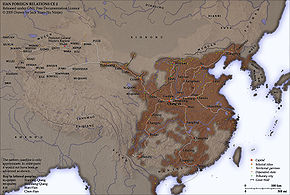
Qin Shi Huangdi ruled the unified China directly with absolute power. In contrast to the decentralized and feudal rule of earlier dynasties the Qin ruled directly. Nationwide the philosophy oflegalismwas enforced and publications promoting rival ideas such as Confucianism were prohibited. In his reign unified China created the first continuousGreat Wallwith the use of forced labour.Invasionswere launched southward to annex Vietnam. The Qin period also saw the standardization of the Chinese writing system and the government unified the legal systems as well as setting standardized units of measurement throughout the empire.[154]After the emperor's death rebellions began and the Han dynasty took power and ruled China for over four centuries with a brief interruption from AD 9 to 23.[155]The Han dynasty promoted the spread of iron agricultural tools, which helped create a food surplus that led to a large growth of population during the Han period. Silk production also increased and the manufacture of paper was invented.[156]Though the Han enjoyed great military and economic success, it was strained by the rise of aristocrats who disobeyed the central government. Public frustration provoked theYellow Turban Rebellion;though a failure it nonetheless accelerated the empire's downfall. After AD 208, the Han dynasty broke up intorival kingdoms.China would remain divided for almost the next 400 years.[157]
Neighbours of China
[edit]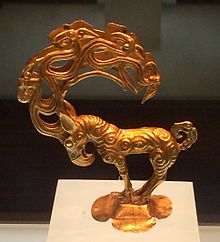
The East Asian nations adjacent to China were all profoundly influenced by their interactions withChinese civilisation.KoreaandVietnamwere brought under Han rule byHan Wudiin the second century BC, and this rule led to cultural influences on both areas for many centuries to come.[160]Wudi also faced a threat from theXiongnu,a nomadic people from the Central Asian steppes. Wudi's invasions ended the Xiongnu state.[161]
In 108 BC, the Han dynasty of China conquered much of Korea but when Han China began its decline,three kingdoms in Korea– those ofBaekje,GoguryeoandSilla– emerged and expelled the Chinese. Goguryeo and Baekje were eventually destroyed by aTang dynastyand Silla alliance. Silla then drove out the Tang dynasty in 676 to control most of the Korean peninsula undisputed.[162]
Jomon cultureformed in Japan before 500 BC and under Chinese influence became theYayoi culturewhich built large tombs by AD 200. In the 300s, a kingdom formed in the Yamato plain, perhaps influenced by Korean refugees.[163]
Americas
[edit]In pre-Columbian times, several large, centralized ancient civilisations developed in theWestern Hemisphere,both inMesoamericaand westernSouth America.[164]Beyond these areas, the use of agriculture expanded East of the Andes Mountains in South America particularly with theMarajoara culture,[citation needed]and in the continental United States.[165]
Andean civilisations
[edit]Ancient Andean civilisation began with the rise of organized fishing communities from 3500 BC onwards. Along with a sophisticated maritime society came the construction of large monuments, which likely existed as community centers.[166]The peoples of this area grew beans, cotton,peanuts,andsweet potatoes,fished in the ocean, and by about 2000 BC had added thepotatoto their crops. TheChavin culture,based around theChavin cult,emerged around 1000 BC and led to large temples and artworks as well as sophisticated textiles. Gold, silver, and copper were worked for jewelry and occasionally for small copper tools.[167]
After the decline of Chavin culture, a number of cities formed after about 200 BC. The cities atHuari,Pucara,andTiahuanacowere all likely over 10,000 residents.[167]From about AD 300, theMochica culturearose along theMoche River.These people left painted pottery depicting their society and culture with a wide range of varied subjects. Besides the Mochica, there were a number of other large states in the Andes after about AD 100.[168]Included amongst these are theNazca culture,who were mainly village-dwelling but left behind a large ceremonial centre atCahuachias well as theNazca lines,a large number of huge designs set into the desert floor.[169]
Mesoamerica
[edit]
Agricultural cultivation began around 8000 BC inMesoamerica,whereavocados,beans,chili peppers,gourds,and squashes were grown from about 7000 BC. Around 4000 BCmaizebegan to be grown, and soon after thistomatoes.Settlements appeared around 3000 BC and by 2000 BC most of Mesoamerica was practicing agriculture. Although some animals were domesticated — notablyturkeysand dogs — the lack of suitable large animals precluded the development of animals used for transportation or labour.[170]
Around 1200 BC the firstOlmeccenter ofSan Lorenzowas founded, which remained the centre of Olmec civilisation until around 800 BC whenLa Ventatook over before losing primacy toTres Zapotesaround 400 BC. These and other Olmec centres were groups of tombs, temples, and other ceremonial sites built of stone. Their construction testifies to the complexity of Olmec society, although the exact nature of how they were governed is not known. They also erected large stone sculptures of human heads and other subjects.Jadejewelry and other Olmec objects are found throughout Mesoamerica, likely having travelled via trade networks. TheOlmec writing systemwas mainly used for recording theircalendar,both of which influenced later Mesoamerican cultures.[171]
After the decline of the Olmecs, other civilisations in Mesoamerica either arose or emerged from the Olmec shadow - theMayans,theZapotecs,andTeotihuacan.[172]The Zapotecs began around 500 BC in theOaxaca Valleyat the site ofMonte Alban.Monte Alban grew to around 25,000 residents in the period around AD 200, with the city having large stone temples and an expansive stone plaza. Like the Olmecs, they had a writing system and calendar. But by AD 900 Monte Alban was deserted for unknown reasons.[173]Teotihuacan developed around AD 200 and centred on the city of Teotihuacan, which grew to perhaps as many as 200,000 inhabitants at its height. Teotihuacan lasted until around AD 700, when it was burned and vandalized.[174]
Maya culturebegan to emerge around AD 300 in theYucatan Peninsulaand modern-day Guatemala. During the 600 years of theClassical Mayaperiod,[175]more than 80 Mayan sites were built, with temples, pyramids, and palaces the focal point of each centre. The most influential wasTikal,but Mayan civilisation was based on city-states which often were at war with each other. This seems not to have restricted trade, which went on between the cities. A priestly elite kept astronomical and calendrical knowledge, recording it with awriting systembased on the Olmec system of glyphs. History, poetry, and other records were recorded in books, most of which did not survive theSpanish conquest of Mesoamerica.Mathematics was also studied, and they used the concept of zero in their calculations. The Mayan civilisation began to decline about AD 800, and most of its cities were deserted soon afterwards.[176]
Northern America
[edit]Organized societies, in the ancient United States or Canada, were often mound builder civilisations. One of the most significant of these was thePoverty Point culturethat existed in the U.S. state of Louisiana, and was responsible for the creation of over 100 mound sites. The Mississippi River was a core area in the development of long-distance trade and culture. Following Poverty Point, successive complex cultures such as the Hopewell emerged in the Southeastern United States in theEarly Woodland period.Before AD 500 many mound builder societies retained a hunter gatherer form of subsistence.
Europe
[edit]Greece
[edit]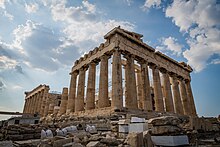
Greece is home to the first advanced civilizations in Europe beginning with theCycladic civilizationon the islands of theAegean Seaaround 3200 BC,[177]and theMinoan civilizationin Crete (2700–1500 BC).[178][179]The Minoans built large palaces decorated with frescoes and wrote in theundeciphered scriptknown asLinear A.TheMycenaeancivilization, the first distinctively Greek civilization later emerged on the mainland (1600–1100 BC), consisting of a network of palace-centered states and writing the earliestattestedform ofGreekwith theLinear Bscript.[179]The Mycenaeans gradually absorbed the Minoans, but collapsed violently around 1200 BC, along with several other civilizations in the eastern Mediterranean, during the regional event known as theLate Bronze Age collapse.[180]This ushered in a period known as theGreek Dark Ages,from which written records are absent.
TheArchaic Periodin Greece is generally considered to have lasted from around the 8th century BC to the invasion by Xerxes in 480 BC. This period saw the expansion of the Greek world around the Mediterranean, with the founding of Greek city-states as far afield as Sicily in the west and the Black Sea in the east.[181]Politically, the Archaic period in Greece saw the collapse of the power of the old aristocracies, with democratic reforms in Athens and the development ofSparta's unique constitution.The end of the Archaic period also saw the rise of Athens, which would come to be a dominant power in theClassical Period,after the reforms ofSolonand the tyranny ofPisistratus.[182]
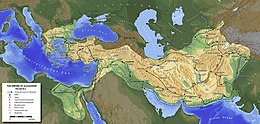
The Classical Greek world was dominated throughout the 5th century BC by the major powers ofAthensandSparta.Through theDelian League,Athens was able to convert pan-hellenist sentiment and fear of the Persian threat into a powerful empire, and this, along with the conflict between Sparta and Athens culminating in thePeloponnesian War,was the majorpoliticaldevelopment of the first part of the Classical period.[183]The period in Greek history from the death of Alexander the Great until the rise of the Roman empire and its conquest of Egypt in 30 BC is known as theHellenistic period.[184]After Alexander's death, a series of wars between his successors eventually led to three large states being formed from parts of Alexander's conquests, each ruled by a dynasty founded by one of the successors. These were theAntigonids,theSelucids,and thePtolemies.[185]These three kingdoms, along with smaller kingdoms, spread Greek culture and lifestyles into Asia and Egypt. These varying states eventually were conquered by Rome or theParthian Empire.[186]
Rome
[edit]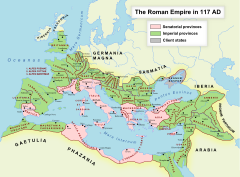
Ancient Romewas a civilisation that grew out of the city-state of Rome, originating as a small agricultural community founded on the Italian peninsula in the 8th century BC, with influences from Greece and other Italian civilisations, such as theEtruscans.Traditionally Rome was founded as amonarchythat then became arepublic.[187]Rome expanded through the Italian peninsula through a series of wars in the fifth through the third centuries BC.[188]This expansion brought the Roman republic into conflict withCarthage,leading to a series ofPunic Wars,that ended with the destruction of Carthage in 146 BC.[189]Rome then expanded into Greece and the eastern Mediterranean,[190]while a series of internal conflicts led to the republic becoming an empire ruled by anemperorby the first century AD.[191]Throughout the first and second centuries AD, the Empire grew slightly while spreading Roman culture throughout its boundaries.[192]
A number of factors led to the eventualdecline of the Roman Empire.The western half of the empire, includingHispania,Gaul,and Italy, eventually broke into independent kingdoms in the 5th century AD;[193]the Eastern Roman Empire, governed fromConstantinople,is referred to as theByzantine Empireafter AD 476,[194]the traditional date for the "fall of Rome" and subsequent onset of theMiddle Ages.[195]
Late antiquity
[edit]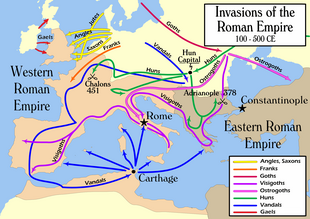
The Roman Empire underwent considerable social, cultural and organizational change starting with reign ofDiocletian,who began the custom of splitting the empire into eastern andwesternhalves ruled by multiple emperors.[196]Constantine the Greatbegan the process ofChristianizingthe empire and established a new capital atConstantinople.[197]MigrationsofGermanic tribesdisrupted Roman rule from the late 4th century onwards, culminating in the eventualcollapse of the empire in the Westin 476, replaced by the so-calledbarbarian kingdoms.[195]The resultant cultural fusion ofGreco-Roman,Germanic and Christian traditions formed the cultural foundations of Europe. There has been attempt by scholars to connect European late antiquity to other areas in Eurasia.[198]
Nomads and Iron Age peoples
[edit]The Celts were a diverse group oftribal societiesinIron Age Europe.Proto-Celticculture formed in theEarly Iron AgeinCentral Europe(Hallstattperiod, named for the site in present-day Austria). By the later Iron Age (La Tèneperiod), Celts had expanded over wide range of lands: as far west asIrelandand theIberian Peninsula,as far east asGalatia(centralAnatolia), and as far north asScotland.[citation needed]By the early centuries AD, following the expansion of the Roman Empire and the Great Migrations of Germanic peoples, Celtic culture had become restricted to theBritish Isles.[199]
TheHunswere a nomadic people who formed a large state in Eastern Europe by about AD 400, and under their leaderAttila,they fought against both sections of the Roman Empire. However, after Attila's death, the state fell apart and the Huns' influence in history disappeared.[200]TheHun-Xiongnuconnection is controversial at best and is often disputed but is also not completely discredited.[201][202]
Migration of Germanic peoples to Britain from what is now northernGermanyand southernScandinaviais attested from the 5th century.[203]Groups ofGothsmigrated into western Europe, with theOstrogothseventually settling in Italy before being conquered by theLombards.[204]A related people, theVisigoths,settled in Spain, founding a kingdom that lasted until it was conquered by Islamic rulers in the AD 700s.[203]
Developments
[edit]Religion and philosophy
[edit]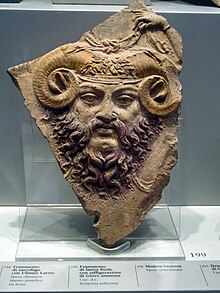
The rise of civilisation corresponded with the institutional sponsorship of belief in gods, supernatural forces and the afterlife.[205]During the Bronze Age, many civilisations adopted their own form of polytheism. Usually, polytheistic Gods manifested human personalities, strengths and failings. Early religion was often based on location, with cities or entire countries selecting a deity, that would grant them preferences and advantages over their competitors. Worship involved the construction of representation of deities, and the granting of sacrifices. Sacrifices could be material goods, food, or in extreme cases human sacrifice to please a deity.[206]New philosophies and religions arose in both east and west, particularly about the 6th century BC. Over time, a great variety of religions developed around the world, with some of the earliest major ones being Hinduism (around 2000 BC),Buddhism(5th century BC), andJainism(6th century BC) inIndia,andZoroastrianisminPersia.TheAbrahamic religionstrace their origin toJudaism,around 1700 BC.[207]
In the east, three schools of thought were to dominate Chinese thinking until the modern day. These wereTaoism,LegalismandConfucianism.The Confucian tradition, which would attain dominance, looked for politicalmoralitynot to the force of law but to the power and example of tradition.[148]Confucianism would later spread into theKorean peninsula[208]andJapan.[209]
In the west, the Greek philosophical tradition, represented bySocrates,Plato,andAristotle,was diffused throughout Europe and the Middle East in the 4th century BC by the conquests of Alexander the Great.[210]After theBronze and Iron Age religionsformed, Christianity spread through the Roman world.[207]
Science and technology
[edit]Ancient technological progress began before the recording of history, with tools, use of fire,[211]domestication of animals, and agriculture all predating recorded history.[212]The use of metals and the ability to make metal alloys was foundational for later technologies to develop.[213]Medical knowledge, including the use of herbs to treat illnesses and wounds as well as some surgical techniques, advanced during antiquity.[214]An early very important development that allowed for further advancement was writing, which allowed humans to record information for later use.[215]
The characteristics ofancient Egyptian technologyare indicated by a set of artifacts and customs that lasted for thousands of years. The Egyptians invented and used many basic machines, such as the ramp and the lever, to aid construction processes. The Egyptians also played an important role in developing Mediterranean maritime technology, including ships.[216]The Babylonians and Egyptians were early astronomers who recorded their observations of the night sky.[217]
Water managingQanatswhich likely emerged on theIranianplateau and possibly also in theArabian peninsulasometime in the early 1st millennium BC spread from there slowly west- and eastward.[218]
TheHindu–Arabic numeral systemwith the concept of zero was developed in India,[219]while modern forms of paper were invented in China in the first century AD.[220]
See also
[edit]References
[edit]Citations
[edit]- ^Stearns, Peter N.(2017). "Periodization in World History: Challenges and Opportunities". In R. Charles Weller (ed.).21st-Century Narratives of World History: Global and Multidisciplinary Perspectives.Palgrave.ISBN978-3-319-62077-0.
- ^DataArchived10 December 2019 at theWayback MachinefromHistory Database of the Global Environment.Archived27 February 2018 at theWayback MachineK. Klein Goldewijk, A. Beusen and P. Janssen, "HYDE 3.1: Long-term dynamic modeling of global population and built-up area in a spatially explicit way", from table on p. 2, Netherlands Environmental Assessment Agency (MNP), Bilthoven, The Netherlands.
- ^Parker 2017,p. 16.
- ^Roberts & Westad 2013,pp. 22–31.
- ^Hart-Davis 2012,p. 18.
- ^Hart-Davis 2012,p. 17.
- ^Wiesner-Hanks 2015,p. 19.
- ^abWiesner-Hanks 2015,p. 26.
- ^abHart-Davis 2012,p. 19.
- ^Parker 2017,pp. 36–37.
- ^abWiesner-Hanks 2015,pp. 45–46.
- ^Parker 2017,p. 44.
- ^Wiesner-Hanks 2015,pp. 48–49.
- ^Wiesner-Hanks 2015,p. 54.
- ^Parker 2017,p. 45.
- ^abcdWiesner-Hanks 2015,pp. 55–56.
- ^abHart-Davis 2012,p. 38.
- ^Roberts & Westad 2013,pp. 59–60.
- ^abcParker 2017,pp. 60–61.
- ^Diamond 1999,p. 218.
- ^abcHart-Davis 2012,p. 58.
- ^Hart-Davis 2012,pp. 60–61.
- ^Hart-Davis 2012,p. 63.
- ^abHart-Davis 2012,pp. 54–55.
- ^Parker 2017,pp. 54–55.
- ^abWiesner-Hanks 2015,p. 74.
- ^Parker 2017,pp. 55–56.
- ^Wiesner-Hanks 2015,p. 73.
- ^Roberts & Westad 2013,p. 65.
- ^Parker 2017,p. 54.
- ^Hart-Davis 2012,p. 54.
- ^Emberling 2015,pp. 256–257.
- ^Wiesner-Hanks 2015,p. 79-80.
- ^abRoberts & Westad 2013,p. 63.
- ^abBentley & Ziegler 2006,p. 38.
- ^abRoberts & Westad 2013,p. 110.
- ^abBentley & Ziegler 2006,p. 36.
- ^Bertram 2003,p. 143.
- ^Bertram 2003,p. 10.
- ^Hart-Davis 2012,p. 80.
- ^Hart-Davis 2012,p. 78.
- ^Bentley & Ziegler 2006,p. 55.
- ^abBentley & Ziegler 2006,pp. 160–161.
- ^Bentley & Ziegler 2006,p. 162.
- ^Bentley & Ziegler 2006,p. 165.
- ^Bentley & Ziegler 2006,p. 166.
- ^abBentley & Ziegler 2006,p. 167.
- ^Bentley & Ziegler 2006,p. 168.
- ^Bentley & Ziegler 2006,pp. 53–54.
- ^Parker 2017,p. 57.
- ^Stager 1998,p. 91.
- ^Dever 2003,p. 206.
- ^Grabbe 2008,pp. 225–226.
- ^Bentley & Ziegler 2006,p. 47.
- ^Roberts & Westad 2013,p. 156.
- ^Bentley & Ziegler 2006,p. 48.
- ^Roberts & Westad 2013,pp. 248–249.
- ^Bentley & Ziegler 2006,pp. 48–49.
- ^abcParker 2017,p. 58.
- ^Parker 2017,p. 49–51.
- ^abRoberts & Westad 2013,p. 338.
- ^Roberts & Westad 2013,pp. 212–213.
- ^Bentley & Ziegler 2006,p. 264.
- ^abParker 2017,pp. 62–63.
- ^abParker 2017,pp. 68–69.
- ^Hart-Davis 2012,p. 64.
- ^Bentley & Ziegler 2006,p. 63.
- ^Bentley & Ziegler 2006,p. 62.
- ^Bentley & Ziegler 2006,p. 73.
- ^Bentley & Ziegler 2006,p. 75.
- ^Hart-Davis 2012,pp. 72–73.
- ^Bentley & Ziegler 2006,pp. 73–74.
- ^Bentley & Ziegler 2006,pp. 77–78.
- ^Bentley & Ziegler 2006,pp. 70–71.
- ^Hart-Davis 2012,pp. 56–57.
- ^Parker 2017,p. 62.
- ^Parker 2017,p. 66.
- ^Bentley & Ziegler 2006,pp. 64–66.
- ^Bentley & Ziegler 2006,pp. 67–69.
- ^Phillipson 2012,p. 48.
- ^Munro-Hay 1991,p. 57.
- ^Shaw 1978.
- ^Bentley & Ziegler 2006,p. 81.
- ^Bentley & Ziegler 2006,pp. 82–83.
- ^abcBentley & Ziegler 2006,p. 87.
- ^Parker 2017,p. 43.
- ^Parker 2017,p. 74.
- ^abBentley & Ziegler 2006,p. 89.
- ^Parker 2017,p. 75.
- ^Bentley & Ziegler 2006,p. 92.
- ^Bentley & Ziegler 2006,p. 94.
- ^Bentley & Ziegler 2006,p. 95.
- ^Bentley & Ziegler 2006,pp. 96–97.
- ^abParker 2017,p. 122.
- ^Parker 2017,p. 123.
- ^Mendis 1999,p. 11.
- ^Wijesooriya 2006,p. 34.
- ^Bentley & Ziegler 2006,p. 212.
- ^Bentley & Ziegler 2006,p. 213.
- ^Tarling, Nicholas (1999).The Cambridge History of Southeast Asia, Volume One, Part One.Cambridge University Press. p. 102.ISBN978-0-521-66369-4.
- ^J. Stephen Lansing (2012).Perfect Order: Recognizing Complexity in Bali.Princeton University Press. p. 22.ISBN978-0-691-15626-2.
- ^abF. Tichelman (2012).The Social Evolution of Indonesia: The Asiatic Mode of Production and Its Legacy.Springer Science & Business Media. p. 41.ISBN978-94-009-8896-5.
- ^Carter, Alison Kyra (2010)."Trade and Exchange Networks in Iron Age Cambodia: Preliminary Results from a Compositional Analysis of Glass Beads".Bulletin of the Indo-Pacific Prehistory Association.30.doi:10.7152/bippa.v30i0.9966(inactive 27 March 2024).Retrieved12 February2017.
{{cite journal}}:CS1 maint: DOI inactive as of March 2024 (link) - ^ab"Pre-Angkorian Settlement Trends in Cambodia's Mekong Delta and the Lower Mekong"(PDF).Anthropology.hawaii.edu. Archived fromthe original(PDF)on 23 September 2015.Retrieved11 February2017.
- ^"Early Mainland Southeast Asian Landscapes in the First Millennium"(PDF).Anthropology.hawaii.edu.Archived(PDF)from the original on 9 October 2022.Retrieved12 February2017.
- ^Higham, Charles; Higham, Thomas; Ciarla, Roberto; Douka, Katerina; Kijngam, Amphan; Rispoli, Fiorella (10 December 2011)."The Origins of the Bronze Age of Southeast Asia".Journal of World Prehistory.24(4): 227–274.doi:10.1007/s10963-011-9054-6.S2CID162300712.Retrieved11 February2017– via Researchgate.net.
- ^Daryl Worthington (1 October 2015)."How and When the Bronze Age Reached South East Asia".New Historian.Retrieved9 March2018.
- ^"history of Southeast Asia".Encyclopædia Britannica.Retrieved11 February2017.
- ^John N. Miksic,Geok Yian Goh, Sue O Connor –Rethinking Cultural Resource Management in Southeast Asia2011 Page 251 "This site dates from the fifth to first century BCE and it is one of the earliest sites of theSa Huỳnhculture in Thu Bồn Valley (Reinecke et al. 2002, 153–216); 2) Lai Nghi is a prehistoric cemetery richly equipped with iron tools and weapons,... "
- ^Ian Glover; Nguyễn Kim Dung.Excavations at Gò Cầm, Quảng Nam, 2000–3: Linyi and the Emergence of the Cham Kingdoms.Academia.edu.Retrieved12 February2017.
- ^abGray RD, Drummond AJ, Greenhill SJ (January 2009). "Language phylogenies reveal expansion pulses and pauses in Pacific settlement".Science.323(5913): 479–83.Bibcode:2009Sci...323..479G.doi:10.1126/science.1166858.PMID19164742.S2CID29838345.
- ^abPawley A (2002). "The Austronesian dispersal: languages, technologies and people". In Bellwood PS, Renfrew C (eds.).Examining the farming/language dispersal hypothesis.McDonald Institute for Archaeological Research, University of Cambridge. pp. 251–273.ISBN978-1-902937-20-5.
- ^abcdBlust, Robert (14 January 2019)."The Austronesian Homeland and Dispersal".Annual Review of Linguistics.5(1): 417–434.doi:10.1146/annurev-linguistics-011718-012440.
- ^Bellwood, Peter (1991). "The Austronesian Dispersal and the Origin of Languages".Scientific American.265(1): 88–93.Bibcode:1991SciAm.265a..88B.doi:10.1038/scientificamerican0791-88.JSTOR24936983.
- ^Gibbons, Ann."'Game-changing' study suggests first Polynesians voyaged all the way from East Asia ".Science.Archivedfrom the original on 13 April 2019.Retrieved23 March2019.
- ^abFreeman, Donald B. (2013).The Pacific.Taylor & Francis. pp. 54–57.ISBN9781136604157.
- ^Van Tilburg, Jo Anne. 1994.Easter Island: Archaeology, Ecology and Culture.Washington D.C.: Smithsonian Institution Press
- ^Langdon, Robert. The Bamboo Raft as a Key to the Introduction of the Sweet Potato in Prehistoric Polynesia,The Journal of Pacific History,Vol. 36, No. 1, 2001
- ^Manguin, Pierre-Yves (2016)."Austronesian Shipping in the Indian Ocean: From Outrigger Boats to Trading Ships".In Campbell, Gwyn (ed.).Early Exchange between Africa and the Wider Indian Ocean World.Palgrave Macmillan. pp. 51–76.ISBN9783319338224.
- ^Tsang, Cheng-hwa (2000). "Recent advances in the Iron Age archaeology of Taiwan".Bulletin of the Indo-Pacific Prehistory Association.20:153–158.doi:10.7152/bippa.v20i0.11751(inactive 12 April 2024).ISSN1835-1794.
{{cite journal}}:CS1 maint: DOI inactive as of April 2024 (link) - ^Turton, M. (17 May 2021)."Notes from central Taiwan: Our brother to the south".Taipei Times.Retrieved24 December2021.
- ^Everington, K. (6 September 2017)."Birthplace of Austronesians is Taiwan, capital was Taitung: Scholar".Taiwan News.Retrieved24 December2021.
- ^Bellwood, Peter; Hung, H.; Lizuka, Yoshiyuki (2011). "Taiwan Jade in the Philippines: 3,000 Years of Trade and Long-distance Interaction". In Benitez-Johannot, P. (ed.).Paths of Origins: The Austronesian Heritage in the Collections of the National Museum of the Philippines, the Museum Nasional Indonesia, and the Netherlands Rijksmuseum voor Volkenkunde.ArtPostAsia.ISBN978-971-94292-0-3.
- ^Bellina, Bérénice (2014). "Southeast Asia and the Early Maritime Silk Road". In Guy, John (ed.).Lost Kingdoms of Early Southeast Asia: Hindu-Buddhist Sculpture 5th to 8th century.Yale University Press. pp. 22–25.ISBN9781588395245.
- ^Mahdi, Waruno (1999). "The Dispersal of Austronesian boat forms in the Indian Ocean". In Blench, Roger; Spriggs, Matthew (eds.).Archaeology and Language III: Artefacts languages, and texts.One World Archaeology. Vol. 34. Routledge. pp. 144–179.ISBN978-0415100540.
- ^abHerrera, Michael B.; Thomson, Vicki A.; Wadley, Jessica J.; Piper, Philip J.; Sulandari, Sri; Dharmayanthi, Anik Budhi; Kraitsek, Spiridoula; Gongora, Jaime; Austin, Jeremy J. (March 2017)."East African origins for Madagascan chickens as indicated by mitochondrial DNA".Royal Society Open Science.4(3): 160787.Bibcode:2017RSOS....460787H.doi:10.1098/rsos.160787.hdl:2440/104470.PMC5383821.PMID28405364.
- ^abTofanelli, S.; Bertoncini, S.; Castri, L.; Luiselli, D.; Calafell, F.; Donati, G.; Paoli, G. (1 September 2009). "On the Origins and Admixture of Malagasy: New Evidence from High-Resolution Analyses of Paternal and Maternal Lineages".Molecular Biology and Evolution.26(9): 2109–2124.doi:10.1093/molbev/msp120.PMID19535740.
- ^abAdelaar, Alexander (June 2012). "Malagasy Phonological History and Bantu Influence".Oceanic Linguistics.51(1): 123–159.doi:10.1353/ol.2012.0003.hdl:11343/121829.
- ^Pierron, Denis; Razafindrazaka, Harilanto; Pagani, Luca; Ricaut, François-Xavier; Antao, Tiago; Capredon, Mélanie; Sambo, Clément; Radimilahy, Chantal; Rakotoarisoa, Jean-Aimé; Blench, Roger M.; Letellier, Thierry; Kivisild, Toomas (21 January 2014)."Genome-wide evidence of Austronesian–Bantu admixture and cultural reversion in a hunter-gatherer group of Madagascar".Proceedings of the National Academy of Sciences.111(3): 936–941.Bibcode:2014PNAS..111..936P.doi:10.1073/pnas.1321860111.PMC3903192.PMID24395773.
- ^Heiske, Margit; Alva, Omar; Pereda-Loth, Veronica; Van Schalkwyk, Matthew; Radimilahy, Chantal; Letellier, Thierry; Rakotarisoa, Jean-Aimé; Pierron, Denis (26 April 2021). "Genetic evidence and historical theories of the Asian and African origins of the present Malagasy population".Human Molecular Genetics.30(R1): R72–R78.doi:10.1093/hmg/ddab018.PMID33481023.
- ^Brucato, N. (2019)."Evidence of Austronesian Genetic Lineages in East Africa and South Arabia: Complex Dispersal from Madagascar and Southeast Asia".Genome Biology and Evolution.11(3): 748–758.doi:10.1093/gbe/evz028.PMC6423374.PMID30715341.Retrieved23 May2024.
- ^abGuan, Kwa Chong (2016)."The Maritime Silk Road: History of an Idea"(PDF).NSC Working Paper(23): 1–30.
- ^abFranck Billé; Sanjyot Mehendale; James W. Lankton, eds. (2022).The Maritime Silk Road(PDF).Amsterdam University Press.ISBN978-90-4855-242-9.
- ^Sulistiyono, Singgih Tri; Masruroh, Noor Naelil; Rochwulaningsih, Yety (2018)."Contest For Seascape: Local Thalassocracies and Sino-Indian Trade Expansion in the Maritime Southeast Asia During the Early Premodern Period".Journal of Marine and Island Cultures.7(2).doi:10.21463/jmic.2018.07.2.05.
- ^Parker 2017,p. 52.
- ^Parker 2017,p. 76.
- ^Hart-Davis 2012,p. 60.
- ^Bentley & Ziegler 2006,p. 111.
- ^Bentley & Ziegler 2006,p. 112.
- ^Bentley & Ziegler 2006,pp. 113–114.
- ^Bentley & Ziegler 2006,pp. 121–125.
- ^Bentley & Ziegler 2006,pp. 115–116.
- ^abRoberts & Westad 2013,pp. 132–133.
- ^Gernet 1996,p. 53.
- ^Bentley & Ziegler 2006,p. 128.
- ^Bentley & Ziegler 2006,p. 118.
- ^Roberts & Westad 2013,pp. 133–135.
- ^abBentley & Ziegler 2006,pp. 182–189.
- ^Gernet 1996,pp. 62–63.
- ^Bentley & Ziegler 2006,p. 119.
- ^Bentley & Ziegler 2006,p. 190.
- ^Gernet 1996,p. 106.
- ^Roberts & Westad 2013,p. 313-.
- ^Bentley & Ziegler 2006,pp. 190–192.
- ^Bentley & Ziegler 2006,pp. 193–194.
- ^Bentley & Ziegler 2006,pp. 197–198.
- ^Bentley & Ziegler 2006,pp. 200–203.
- ^Rawson 1999.
- ^"Shaanxi History Museum notice".Shaanxi History Museum.Archivedfrom the original on 14 January 2021.Retrieved18 October2020.
- ^Bentley & Ziegler 2006,pp. 195–196.
- ^Bentley & Ziegler 2006,pp. 196–197.
- ^Parker 2017,p. 150.
- ^Parker 2017,p. 144.
- ^Parker 2017,p. 78.
- ^Bentley & Ziegler 2006,p. 548.
- ^jseagard (2 February 2011)."Proyecto Arqueológico Norte Chico".Field Museum.Archived fromthe originalon 10 March 2020.Retrieved14 March2019.
- ^abBentley & Ziegler 2006,pp. 146–147.
- ^Bentley & Ziegler 2006,pp. 147–148.
- ^Parker 2017,p. 131.
- ^Bentley & Ziegler 2006,p. 135.
- ^Bentley & Ziegler 2006,pp. 136–138.
- ^Parker 2017,pp. 128–129.
- ^Parker 2017,p. 129.
- ^Parker 2017,p. 128.
- ^Parker 2017,p. 130.
- ^Bentley & Ziegler 2006,pp. 137–141.
- ^Sansone, David (2011).Ancient Greek civilization.Wiley. p. 5.ISBN9781444358773.
- ^Frucht, Richard C (31 December 2004).Eastern Europe: An Introduction to the People, Lands, and Culture.ABC-CLIO. p. 847.ISBN978-1-57607-800-6.Retrieved5 December2012.
People appear to have first entered Greece as hunter-gatherers from southwest Asia about 50,000 years... of Bronze Age culture and technology laid the foundations for the rise of Europe's first civilization, Minoan Crete
- ^abWorld and Its Peoples.Marshall Cavendish. September 2009. p. 1458.ISBN978-0-7614-7902-4.Retrieved5 December2012.
Greece was home to the earliest European civilizations, the Minoan civilization of Crete, which developed around 2000 BC, and the Mycenaean civilization on the Greek mainland, which emerged about 400 years later
- ^Drews, Robert(1995).The End of the Bronze Age: Changes in Warfare and the Catastrophe Ca. 1200 BC.Princeton University Press. p. 3.ISBN0691025916.
- ^Boardman & Hammond 1970,p. xiii.
- ^Boardman & Hammond 1970,p. xv.
- ^Lewis et al. 1992,pp. xiii–xiv.
- ^Hart-Davis 2012,p. 99.
- ^Parker 2017,p. 98.
- ^Hart-Davis 2012,pp. 98–99.
- ^Hart-Davis 2012,pp. 106–107.
- ^Parker 2017,p. 101.
- ^Parker 2017,pp. 102–103.
- ^Hart-Davis 2012,pp. 110–111.
- ^Parker 2017,pp. 104–105.
- ^Hart-Davis 2012,pp. 110–113.
- ^Parker 2017,p. 113.
- ^Hart-Davis 2012,pp. 198–199.
- ^abHart-Davis 2012,pp. 150–151.
- ^Parker 2017,pp. 110–111.
- ^Parker 2017,p. 112.
- ^Humphries, Mark (2017)."Late Antiquity and World History".Studies in Late Antiquity.1(1): 8–37.doi:10.1525/sla.2017.1.1.8.ISSN2470-2048.
- ^Parker 2017,p. 114.
- ^Parker 2017,p. 111.
- ^Wright 2011,p. 60.
- ^de la Vaissière 2015,p. 188.
- ^abParker 2017,p. 163.
- ^Parker 2017,p. 162.
- ^Hart-Davis 2012,pp. 40–41.
- ^Hart-Davis 2012,pp. 142–143.
- ^abHart-Davis 2012,pp. 144–147.
- ^Bentley & Ziegler 2006,p. 396.
- ^Bentley & Ziegler 2006,p. 397.
- ^Hart-Davis 2012,pp. 130–131.
- ^Hart-Davis 2012,pp. 24–29.
- ^Hart-Davis 2012,pp. 36–37.
- ^Hart-Davis 2012,pp. 42–43.
- ^Hart-Davis 2012,pp. 52–53.
- ^Hart-Davis 2012,pp. 62–63.
- ^Shaw 2012,pp. 117–119.
- ^Hart-Davis 2012,p. 104.
- ^Wilson 2008,pp. 292–293.
- ^Bentley & Ziegler 2006,p. 225.
- ^Hart-Davis 2012,p. 129.
Sources
[edit]- Bentley, Jerry H.;Ziegler, Herbert F. (2006).Traditions & Encounters: A Global Perspective on the Past Volume I: From the Beginning to 1500(3rd ed.). Boston:McGraw Hill.ISBN978-0-07-299827-6.
- Bertram, Stephen (2003).Handbook to Life in Ancient Mesopotamia.Oxford:Oxford University Press.ISBN978-0-19-518364-1.
- Boardman, John;Hammond, N. G. L.,eds. (1970). "Preface".The Cambridge Ancient History Volume III, Part 3: The Expansion of the Greek World, Eighth to Sixth Centuries B.C.ISBN978-0-521-23447-4.
- de la Vaissière, Étienne(2015). "The Steppe World and the Rise of the Huns". In Maas, Michael (ed.).The Cambridge Companion to the Age of Attila.Cambridge:Cambridge University Press.pp. 175–192.ISBN978-1-107-63388-9.
- Dever, William(2003).Who Were the Early Israelites and Where Did They Come From?.Eerdmans.ISBN978-0-8028-0975-9.
- Diamond, Jared(1999).Guns, Germs, and Steel: The Fates of Human Societies.New York:W. W. Norton & Company.
- Emberling, Geoff (2015). "Mesopotamian cities and urban process, 3500–1600 BCE". In Yoffee, Norman (ed.).The Cambridge World History: Volume III: Early Cities in Comparative Perspective, 4000 BCE–1200 CE.Cambridge:Cambridge University Press.pp. 253–278.ISBN978-0-521-19008-4.
- Gernet, Jacques (1996).A History of Chinese Civilization.Translated by Foster, J. R.; Hartman, Charles (Second ed.). Cambridge:Cambridge University Press.ISBN978-0-521-49781-7.
- Grabbe, Lester L., ed. (2008).Israel in Transition: From Late Bronze II to Iron IIa (c. 1250–850 B.C.E.).T&T ClarkInternational.ISBN978-0-567-02726-9.
- Hart-Davis, Adam,ed. (2012).History: The Definitive Visual Guide.New York:DK.ISBN978-0-7566-7609-4.
- Lewis, D.M.; Boardman, John; Davies, J.K.; et al., eds. (1992). "Preface".The Cambridge Ancient History Volume V: The Fifth Century B.C.Cambridge University Press.ISBN978-0-521-23347-7.
- Mendis, Ranjan Chinthaka (1999).The Story of Anuradhapura.Kotte: Lakshmi Mendis.ISBN978-955-96704-0-7.
- Munro-Hay, Stuart (1991).Aksum: An African Civilization of Late Antiquity.Edinburgh:Edinburgh University Press.ISBN978-0-7486-0106-6.
- Parker, Philip (2017).World History: From the Ancient World to the Information Age(Revised ed.). New York:DK.ISBN978-1-4654-6240-4.
- Phillipson, David(2012)."Aksum".In Neil Asher Silberman (ed.).The Oxford Companion to Archaeology(Second ed.). Oxford University Press.ISBN978-0-19-973921-9.Archivedfrom the original on 30 July 2022.Retrieved11 June2022.
- Rawson, Jessica (1999)."Design Systems in Early Chinese Art".Orientations:52. Archived fromthe originalon 18 October 2020.Retrieved18 October2020.
- Roberts, J. M.; Westad, Odd Arne (2013).The Penguin History of the World(Sixth ed.). New York:Penguin Books.ISBN978-1-84614-443-1.
- Shaw, Ian (2012).Ancient Egyptian technology and Innovation: Transformations in Pharaonic Material Culture.London:Bristol Classical Press.ISBN978-1-4725-1959-7.
- Shaw, Thurstan (1978).Nigeria: Its Archaeology and Early History.London:Thames and Hudson.ISBN978-0-500-02086-9.
- Stager, Lawrence E. (1998). "Forging an Identity: The Emergence of Ancient Israel". In Coogan, Michael D. (ed.).The Oxford History of the Biblical World.Oxford University Press.ISBN978-0-19-513937-2.
- Wiesner-Hanks, Merry E.(2015).Concise History of the World.Cambridge:Cambridge University Press.ISBN978-1-107-69453-8.
- Wijesooriya, S. (2006).A Concise Sinhala Mahavamsa.Kotte: Participatory Development Forum.ISBN978-955-9140-31-3.
- Wilson, Andrew(2008). "Hydraulic Engineering and Water Supply". InOleson, John Peter(ed.).Handbook of Engineering and Technology in the Classical World.Oxford:Oxford University Press.pp. 285–318.ISBN978-0-19-973485-6.
- Wright, David Curtis (2011).The History of China(2nd ed.). Santa Barbara:Greenwood.ISBN978-0-313-37748-8.
Further reading
[edit]- Hodges, Henry; Newcomer, Judith (1992).Technology in the Ancient World.Barnes & Noble.ISBN978-0-88029-893-3.
- Kinzl, Konrad H. (1998).Directory of Ancient Historians in the USA, 2nd ed.Claremont, Calif.: Regina Books.ISBN978-0-941690-87-4.Archived fromthe originalon 15 February 2010.Retrieved24 February2008.Web edition is constantly updated.
- Toffteen, Olaf Alfred (1907).Ancient Chronology.University of Chicago Press.
- Thomas, Carol G.; D.P. Wick (1994).Decoding Ancient History: A Toolkit for the Historian as Detective.Englewood Cliffs, N.J.: Prentice Hall.ISBN978-0-13-200205-9.
External links
[edit]Websites
[edit]- World History Encyclopedia
- Ancient Civilizations–British Museum's website on various topics of ancient civilisation
- Ancient history sourcebook
- The Perseus digital library
- Barrington Atlas of the Greek and Roman world
Directories
[edit]- Ancient_historyatCurlie
- Ancient History– Academic Info: directory of online resources for the study of ancient history.
- Ancient History Resources:Ancient history research links for high school and college students.

